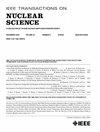A Gamma-Ray Imaging Detector Using Position-Sensitive SiPM Coupled to GAGG:Ce Scintillator Array
IF 1.9
3区 工程技术
Q3 ENGINEERING, ELECTRICAL & ELECTRONIC
引用次数: 0
Abstract
Position-sensitive scintillator detectors are critical components in coded-aperture imaging and Compton imaging systems. Improving the position resolution and energy resolution of the detector is crucial for system performance. Traditional position sensitive scintillator detectors are constrained by the size of photoelectric readout devices and the number of readout channels, making it difficult to achieve both high position resolution and energy resolution at a low cost. This study presents a novel gamma-ray imaging detector that overcomes the traditional trade-off between position resolution, energy resolution, and cost. Using a high-resolution cerium-doped gadolinium aluminum gallium garnet (GAGG:Ce) scintillator array (位置敏感SiPM与GAGG:Ce闪烁体阵列耦合的伽玛射线成像探测器
位置敏感闪烁体探测器是编码孔径成像和康普顿成像系统的关键部件。提高探测器的位置分辨率和能量分辨率对系统性能至关重要。传统的位置敏感闪烁体探测器受到光电读出器件尺寸和读出通道数量的限制,难以以低成本同时实现高位置分辨率和能量分辨率。本研究提出了一种新的伽玛射线成像探测器,克服了传统的位置分辨率、能量分辨率和成本之间的权衡。利用位置敏感硅光电倍增管(PS-SiPM)通过其四个阳极读出的高分辨率掺铈钆铝镓石榴石(GAGG:Ce)闪烁体阵列($0.5\ × 0.5\ × 5$ mm像素),我们实现了直接位置重建,而无需使用光共享技术。用137Cs源测试了该成像探测器的性能。它展示了一个清晰的分割$10\ × 10$阵列,能量分辨率为7.2%[全宽度半最大(FWHM)],为662 keV,显着简化了电子读出系统的设计。
本文章由计算机程序翻译,如有差异,请以英文原文为准。
求助全文
约1分钟内获得全文
求助全文
来源期刊

IEEE Transactions on Nuclear Science
工程技术-工程:电子与电气
CiteScore
3.70
自引率
27.80%
发文量
314
审稿时长
6.2 months
期刊介绍:
The IEEE Transactions on Nuclear Science is a publication of the IEEE Nuclear and Plasma Sciences Society. It is viewed as the primary source of technical information in many of the areas it covers. As judged by JCR impact factor, TNS consistently ranks in the top five journals in the category of Nuclear Science & Technology. It has one of the higher immediacy indices, indicating that the information it publishes is viewed as timely, and has a relatively long citation half-life, indicating that the published information also is viewed as valuable for a number of years.
The IEEE Transactions on Nuclear Science is published bimonthly. Its scope includes all aspects of the theory and application of nuclear science and engineering. It focuses on instrumentation for the detection and measurement of ionizing radiation; particle accelerators and their controls; nuclear medicine and its application; effects of radiation on materials, components, and systems; reactor instrumentation and controls; and measurement of radiation in space.
 求助内容:
求助内容: 应助结果提醒方式:
应助结果提醒方式:


